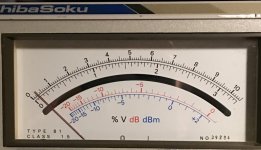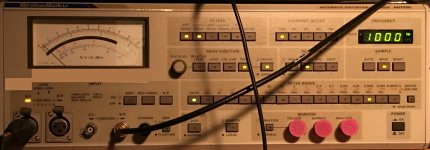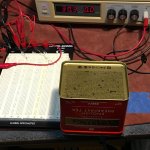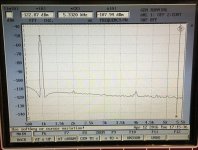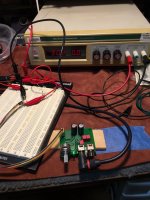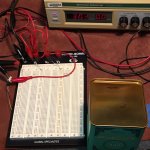My Question for the Post# 1880, 1884 plot is this:
Was that made with the blinking warning LED?
It seems my unit goes to -3dB then it starts it bloody warning.
The plot Demian included shows -2dB, 0dB, +2dB.
Those are 1dB, 3dB, and 5dB more than Quant says is
their specification.
OR
Am I misinterpreting the information.
When does the input of the QA400 start to
be destroyed? At what dB level.
I haven't looked, I think there is some export
mechanism with the QA400 software, yes?
Cheers,
Sync
Was that made with the blinking warning LED?
It seems my unit goes to -3dB then it starts it bloody warning.
The plot Demian included shows -2dB, 0dB, +2dB.
Those are 1dB, 3dB, and 5dB more than Quant says is
their specification.
OR
Am I misinterpreting the information.
When does the input of the QA400 start to
be destroyed? At what dB level.
I haven't looked, I think there is some export
mechanism with the QA400 software, yes?
Cheers,
Sync
Simple math question:
If I do the math correctly for the following reading on my 725D meter:
Measured: 1V, 1,072kHz, w/400HPF, A weighing.
Meter reading: .045 percent, .001 percent range.
Math: .045 * .001 = 0.000045 percent THD.
I need to check my log, I think 1V, 1kHz was at .05 percent @.001 percent range.
Math: .05 * .001 = 0.00005 percent THD.
What does Victors Oscillator 1V, 1kHz do? THD 725 vs e-MU?
If I do the math correctly for the following reading on my 725D meter:
Measured: 1V, 1,072kHz, w/400HPF, A weighing.
Meter reading: .045 percent, .001 percent range.
Math: .045 * .001 = 0.000045 percent THD.
I need to check my log, I think 1V, 1kHz was at .05 percent @.001 percent range.
Math: .05 * .001 = 0.00005 percent THD.
What does Victors Oscillator 1V, 1kHz do? THD 725 vs e-MU?
@ Dunhill,
I don't know answer to that inter-modulation question,
you will have to try it and measure.
That said, Depending on the discreet oAamp, what are you emulating,
building? It would be interesting to test the opAmp IC and compare
notes as well as the discreet opAmp and compare the results.
I don't know answer to that inter-modulation question,
you will have to try it and measure.
That said, Depending on the discreet oAamp, what are you emulating,
building? It would be interesting to test the opAmp IC and compare
notes as well as the discreet opAmp and compare the results.
My questions are pretty simple. I have a differential input/output test thing and a unity gain stable opamp to test. I suppose measuring it as a buffer is a good place to start, with just the QA401 in SE mode? Then at a few different gain levels? What's the standard battery of tests here that I can do with my new toy?
Simple math question:
If I do the math correctly for the following reading on my 725D meter:
Measured: 1V, 1,072kHz, w/400HPF, A weighing.
Meter reading: .045 percent, .001 percent range.
Math: .045 * .001 = 0.000045 percent THD.
I need to check my log, I think 1V, 1kHz was at .05 percent @.001 percent range.
Math: .05 * .001 = 0.00005 percent THD.
What does Victors Oscillator 1V, 1kHz do? THD 725 vs e-MU?
You converted from percent to voltage.
The meter is FS 100% @ 10. If you read 1 on the meter that is 10%
10% of .001% is 0.0001%. % to voltage is %/100. So 0.0001% /100
0.000001 Vrms or -120dBV
Doing the math
David,
If I follow your example above, 10% of 0.001% is:
0.1 * 0.001 = 0.0001 Percent.
At the 0.001 Percent METER RANGE setting
FS (Full Scale) the needle would be on the 10 mark.
Following the needle down, it would correspond to 0 dB.
IF the needle was in that position it would correspond to -100dB.
The Meter Scales are concentric:
%
V
dB
dBm
In the example that you gave above, on the percent scale (upper)
IF the needle was on the 1, that would correspond to
10 Percent OR -20 dB change to the METER RANGE.
NOTE: To those following the 725D has a series of push buttons
to the right of the Meter, see the attachment.
I would multiply 0.1 * 0.001 = 0.0001 Percent
OR
add -20 dB to -100 dB, -100 plus -20 = -120 dB.
I think 0.0001 percent equals -120 dB (approx.)
In the indication below (for the sake of argument) on the top scale
the needle indicates point 3 (.03 percent). The mid point to the
number 1 on the meter would be point 5 or .05 percent.
1 corresponds to 10 percent or .1 %.
So the math would be:
0.03 * 0.001 = 0.00003 percent or right around -130 dB.
If my statement's are incorrect please assist as I have to re-think.
Cheers,
Sync
You converted from percent to voltage.
The meter is FS 100% @ 10. If you read 1 on the meter that is 10%
10% of .001% is 0.0001%. % to voltage is %/100. So 0.0001% /100
0.000001 Vrms or -120dBV
David,
If I follow your example above, 10% of 0.001% is:
0.1 * 0.001 = 0.0001 Percent.
At the 0.001 Percent METER RANGE setting
FS (Full Scale) the needle would be on the 10 mark.
Following the needle down, it would correspond to 0 dB.
IF the needle was in that position it would correspond to -100dB.
The Meter Scales are concentric:
%
V
dB
dBm
In the example that you gave above, on the percent scale (upper)
IF the needle was on the 1, that would correspond to
10 Percent OR -20 dB change to the METER RANGE.
NOTE: To those following the 725D has a series of push buttons
to the right of the Meter, see the attachment.
I would multiply 0.1 * 0.001 = 0.0001 Percent
OR
add -20 dB to -100 dB, -100 plus -20 = -120 dB.
I think 0.0001 percent equals -120 dB (approx.)
In the indication below (for the sake of argument) on the top scale
the needle indicates point 3 (.03 percent). The mid point to the
number 1 on the meter would be point 5 or .05 percent.
1 corresponds to 10 percent or .1 %.
So the math would be:
0.03 * 0.001 = 0.00003 percent or right around -130 dB.
If my statement's are incorrect please assist as I have to re-think.
Cheers,
Sync
Attachments
Last edited:
Your numbers are correct, however levels below 10% of the meters range are going to be of degraded accuracy. This is where an external calibrated FFT becomes very helpful.
Victors oscillators can have harmonics in the -140 dB range. The newer ones are better than my first gen samples. I will buy an updated set soon.
Victors oscillators can have harmonics in the -140 dB range. The newer ones are better than my first gen samples. I will buy an updated set soon.
Your numbers are correct, however levels below 10% of the meters range are going to be of degraded accuracy. This is where an external calibrated FFT becomes very helpful.
Victors oscillators can have harmonics in the -140 dB range. The newer ones are better than my first gen samples. I will buy an updated set soon.
Okay, got it Damien, I thought I was doing the numbers correctly,
this is where the button on the far right side of the METER RANGE
buttons, we press it for an additional -10dB of gain, which puts the needle
above the 10 percent range.
When I've done this it corresponds to the 725D's under 10 percent indication.
And I do have a self calibrating FFT. Small screen and it runs under DOS.
I'll have to get a separate monitor for the screen output.
So yes, I did get my Victor's Oscillator working again. Lambda Power Supply
wasn't so good with Oscillator. Measured 0.1 percent on 0.01 percent scale.
For THD of 0.001 %. 400Hz and "A" weighting.
Best was using a Beckman Medical PS at battery voltage specs.
That was four 9 V batteries?
It lowered THD to .1% on .001% range. The can didn't make
a difference with the lower battery type voltage range.
Here are two pics, one of the set up, the other is the FFT.
FYI - the tin didn't make a difference, neither did the
tin's orientation. In this case I used the 30V PS, the
max it could do.
Cheers,
Sync
Attachments
Last edited:
David,
If I follow your example above, 10% of 0.001% is:
0.1 * 0.001 = 0.0001 Percent.
At the 0.001 Percent METER RANGE setting
FS (Full Scale) the needle would be on the 10 mark.
Following the needle down, it would correspond to 0 dB.
IF the needle was in that position it would correspond to -100dB.
The Meter Scales are concentric:
%
V
dB
dBm
In the example that you gave above, on the percent scale (upper)
IF the needle was on the 1, that would correspond to
10 Percent OR -20 dB change to the METER RANGE.
NOTE: To those following the 725D has a series of push buttons
to the right of the Meter, see the attachment.
I would multiply 0.1 * 0.001 = 0.0001 Percent
OR
add -20 dB to -100 dB, -100 plus -20 = -120 dB.
I think 0.0001 percent equals -120 dB (approx.)
In the indication below (for the sake of argument) on the top scale
the needle indicates point 3 (.03 percent). The mid point to the
number 1 on the meter would be point 5 or .05 percent.
1 corresponds to 10 percent or .1 %.
So the math would be:
0.03 * 0.001 = 0.00003 percent or right around -130 dB.
If my statement's are incorrect please assist as I have to re-think.
Cheers,
Sync
Point 3 on the meter is 3% not .03%. 3% is the fraction 0.03 and your result is correct but your sticking percent in where it doesn't belong.
The meter is scaled 0 to 10 which is 0 to 100%. The meter scale is not in percent it's a factional part. If you want it in percent then multiply the meter reading by 10.
Last edited:
Sync-
Below -100 dB (.001%) using percent to describe the number creates the opportunity to have lots of errors. On the 725D the lowest range is .001% for THD+N and .0003% for THD. The meter will read from full scale (.001%) at 10 being .001% to 1 being .0001%. Similar for the .0003% scale. But with all of those zeros we all get like politicians and stop counting. Stick to dB which is easier to mange and harder to get the wrong range and scale with.
Below -100 dB (.001%) using percent to describe the number creates the opportunity to have lots of errors. On the 725D the lowest range is .001% for THD+N and .0003% for THD. The meter will read from full scale (.001%) at 10 being .001% to 1 being .0001%. Similar for the .0003% scale. But with all of those zeros we all get like politicians and stop counting. Stick to dB which is easier to mange and harder to get the wrong range and scale with.
Thank you David and Demian.
Yes, thanks for the clarifications and corrections.
Just trying to be precise with the language and proper terminology,
which it makes for confusion until I get it right.
Yes, point 3 is 3 percent, or 3 %, a.k.a. .03 decimal 🙂
No worries as long as the number comes out right.
Demian, David likes to use percent because it has higher
accuracy down as the lower end, where dB seems to run out of gas.
Then we can convert to dB if needed, etc.
I've started to use percent since David recommended it,
especially with the 725D.
Since we are discussing it 725D, not to hi jack the thread,
I had one final question. When I use 400 LPF with A weighting
when taking the oscillator measurements I did notice higher
THD numbers than using 400 LPF with 20k or 30k which
gives a lower THD number.
Is that correct as it should be or is there issues with A?
Cheers,
Sync
Yes, thanks for the clarifications and corrections.
Just trying to be precise with the language and proper terminology,
which it makes for confusion until I get it right.
Yes, point 3 is 3 percent, or 3 %, a.k.a. .03 decimal 🙂
No worries as long as the number comes out right.
Demian, David likes to use percent because it has higher
accuracy down as the lower end, where dB seems to run out of gas.
Then we can convert to dB if needed, etc.
I've started to use percent since David recommended it,
especially with the 725D.
Since we are discussing it 725D, not to hi jack the thread,
I had one final question. When I use 400 LPF with A weighting
when taking the oscillator measurements I did notice higher
THD numbers than using 400 LPF with 20k or 30k which
gives a lower THD number.
Is that correct as it should be or is there issues with A?
Cheers,
Sync
Thank you David and Demian.
Yes, thanks for the clarifications and corrections.
Just trying to be precise with the language and proper terminology,
which it makes for confusion until I get it right.
Yes, point 3 is 3 percent, or 3 %, a.k.a. .03 decimal 🙂
No worries as long as the number comes out right.
Demian, David likes to use percent because it has higher
accuracy down as the lower end, where dB seems to run out of gas.
Then we can convert to dB if needed, etc.
I've started to use percent since David recommended it,
especially with the 725D.
Since we are discussing it 725D, not to hi jack the thread,
I had one final question. When I use 400 LPF with A weighting
when taking the oscillator measurements I did notice higher
THD numbers than using 400 LPF with 20k or 30k which
gives a lower THD number.
Is that correct as it should be or is there issues with A?
Cheers,
Sync
I guess the A weighting filters are generating noise.
But why would you want to use the A weighting. It's a lie. The only purpose for A weighting is to make things look better than they really are. I think it was invented by marketing.
Working in percent is no more accurate than anything else. The scale goes lower on the 725 that's all. If you look just about everything I post in is dBV. It's good to know how to work in any of the scales, %, dB and dBm and dBu. Not sure where this ppm stuff comes from. Looks good in print I guess.
I don't know how the ppm stuff started. We certainly can't hear it.
In the 0.0001% example it would correspond to 1 ppm.
Convert to decimal units and count the places, tenths, hundredths,
.000,001
It works for physical measurements, particulates, etc.
Cheers,
Sync
In the 0.0001% example it would correspond to 1 ppm.
Convert to decimal units and count the places, tenths, hundredths,
.000,001
It works for physical measurements, particulates, etc.
Cheers,
Sync
A weighting is useful for evaluating the intrusion of noise and comparing between measurement systems since it defines the bandwidth. Its meaningless or worse for distortion measurements. Ideally for low noise perception the CCIR/ARM or https://en.wikipedia.org/wiki/ITU-R_468_noise_weighting is preferable but not implemented widely.
The 400 Hz filter is to get rid of hum. I think its in front of some of the notches so it will introduce distortion. the 20 KHz LP filter will muck things up. Its useful for digital measurements but the implementation is not up to the task.
I think PPM started with McIntosh marketing talking about less than 10 parts per million from perfection. Its really distracting.
dB below the reference is really the only useful metric for this ultra low distortion stuff.
The 400 Hz filter is to get rid of hum. I think its in front of some of the notches so it will introduce distortion. the 20 KHz LP filter will muck things up. Its useful for digital measurements but the implementation is not up to the task.
I think PPM started with McIntosh marketing talking about less than 10 parts per million from perfection. Its really distracting.
dB below the reference is really the only useful metric for this ultra low distortion stuff.
More on noise and weighted distortion:
Present usage of 468-weighting
468-weighting is also used in weighted distortion measurement at 1 kHz. Weighting the distortion residue after removal of the fundamental emphasises high-order harmonics, but only up to 10 kHz or so where the ears response falls off. This results in a single measurement (sometimes called distortion residue measurement) which has been claimed to correspond well with subjective effect even for power amplifiers where crossover distortion is known to be far more audible than normal THD (Total harmonic distortion) measurements would suggest.
Present usage of 468-weighting
468-weighting is also used in weighted distortion measurement at 1 kHz. Weighting the distortion residue after removal of the fundamental emphasises high-order harmonics, but only up to 10 kHz or so where the ears response falls off. This results in a single measurement (sometimes called distortion residue measurement) which has been claimed to correspond well with subjective effect even for power amplifiers where crossover distortion is known to be far more audible than normal THD (Total harmonic distortion) measurements would suggest.
Thanks Demian,
If I'm comprehending we'd use A weighting to compare different Amps,
different pre amps, or other test gear used to compare them with
with eachother or compare the analyzers.
good thinking.
Cheers,
Sync
If I'm comprehending we'd use A weighting to compare different Amps,
different pre amps, or other test gear used to compare them with
with eachother or compare the analyzers.
good thinking.
Cheers,
Sync
In the 725D The 20kHz is before the notch filter. All other filters are post notch and add no distortion or noise to the measurement.
In the 725B/C all the filters are post notch. I'm not sure about the 20kHz filter.
In the 725B/C all the filters are post notch. I'm not sure about the 20kHz filter.
Thanks Demian,
If I'm comprehending we'd use A weighting to compare different Amps,
different pre amps, or other test gear used to compare them with
with eachother or compare the analyzers.
good thinking.
Cheers,
Sync
Dolby did a paper many years back in which he demonstrated that the human perception of "noise" conformed much better to the ITU-486 weighting regimen. Better still when the measurements were performed "average" rather than RMS.
Here's the filter for the Boonton 1120:
An externally hosted image should be here but it was not working when we last tested it.
The singular virtue of A weighting is its consistent limited bandwidth. You should get the same SNR with pretty much any measurement system. For the most part this makes for comparable measurements and its widely used. if you want to explore how intrusive the noise is the ITU-486 is more useful. For electronics I don't think its important today but for other things, in my case noise cancelling headphones, its very important.
- Home
- Design & Build
- Equipment & Tools
- QuantAsylum QA400 and QA401
